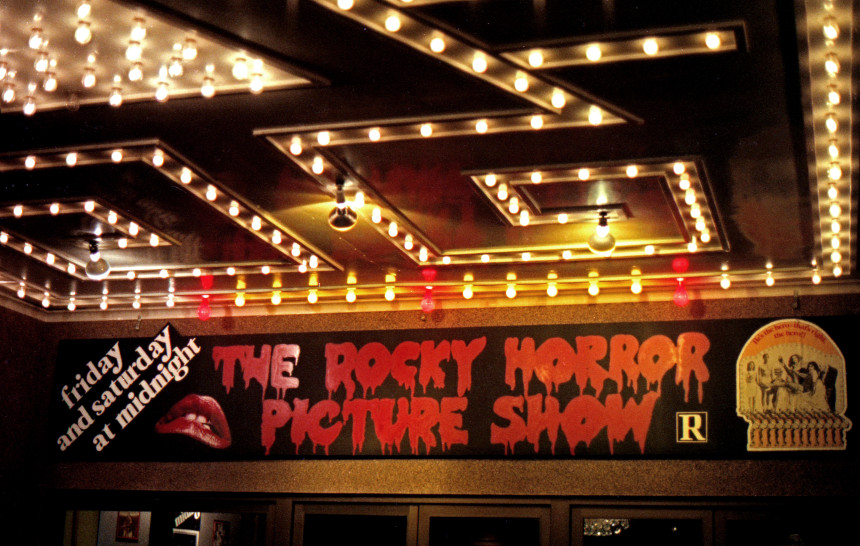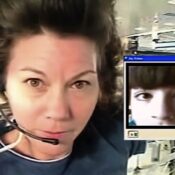Having performed in both the touring and London productions of Hair in the early 1970s, Richard O’Brien combined his love of science fiction, horror, and comic books with his stage background into writing the musical The Rocky Horror Show. The play rapidly grew in popularity, moving from theatre to bigger theatre in England. When the opportunity came to take the tale to the screen in 1975, little did anyone involved know that their film would still be playing around the world 45 years later. I would like, if I may, to take you on a strange journey . . . this is the story of The Rocky Horror Picture Show.
O’Brien was born in England in 1942 and moved to New Zealand with his family in the 1950s. After college, he went back to England in 1964 and began working on stage and in film. O’Brien played both an Apostle and Leper in the London production of Jesus Christ Superstar; the director who cast him was Jim Sharman. Sharman would cast him again, and O’Brien shared his idea for They Came from Denton High, a musical send-up of the things that he loved, like 1950s science-fiction movies. Sharman came on board as director and gave O’Brien the idea for a new name: The Rocky Horror Show. In June 1973, the show kicked off at London’s Theatre Upstairs; it quickly became a hit, moving to bigger venues until making it to the U.K’s equivalent of Broadway, the West End.
Lou Adler was already a big name in American music when he saw Rocky in London. Adler had produced Carole King’s Tapestry, the Monterey Pop Festival, and six hits for The Mamas and The Papas, including “California Dreamin’.” He bought the U.S. theatrical rights, taking the show to the Roxy in L.A. Soon after, Michael White, who had produced the London shows, Adler, O’Brien, and Sharman were collaborating on a film version. Adler and White produced with Sharman directing and co-writing the screen adaptation with O’Brien.
The trailer for The Rocky Horror Picture Show (Uploaded to YouTube by 20th Century Studios)
In terms of casting, several members of the London cast made the jump to screen. Tim Curry (Dr. Frank-N-Furter), O’Brien (Riff Raff), Patricia Quinn (Magenta), and “Little Nell” Campbell (Columbia) had all been in productions in England. The ostensible lead roles of Brad and Janet were trickier, as studio 20th Century Fox wanted American actors in the parts; those ended up being filled by Barry Bostwick and Susan Sarandon. Charles Gray, a two-time Bond villain, played the criminologist/narrator and Jonathan Adams was cast as Dr. Scott. Marvin Lee Aday, better known as Meat Loaf, was a veteran of Broadway’s Hair and had played Eddie in the L.A. cast; he reprised Eddie for the movie, two years before the release of his massively successful Bat Out of Hell album. Background character Betty Munroe (whose wedding Brad and Janet attend early in the film) was played by Hilary Labow, which was the screen name of Hilary Farr, known today as the designer on the long-running renovation series Love It or List It.
Much of the Gothy, classic horror mood of the film came from the location at Oakley Court. The estate had been used in several Hammer Studios films, including The Brides of Dracula and The Plague of the Zombies. In Sharman’s direction, you can occasionally note some of the same wide angles and sudden zooms prevalent in Hammer features, which were meant to echo styles prevalent in the genre. Richard Hartley produced the soundtrack and handled musical arrangements on the songs that O’Brien had written. The soundtrack lists 21 official numbers, although “Once in a While” came from a deleted scene and “Super Heroes” was only seen in the U.K. until the eventual video release.
A portion of “Sweet Transvestite” from The Rocky Horror Picture Show (Uploaded to YouTube by Movieclips)
The film opened 45 years ago this week in London, with the U.S. opening a few weeks later. It was not an immediate success. Outside of L.A., it was quickly pulled from theatres. Tim Deegan, a Fox executive, suggested an alternative strategy; figuring that the film might do well on the midnight circuit, as John Waters films had, Deegan got the ball rolling in New York. The Waverly Theater became ground zero for a cult phenomenon, fostering audience participation in the form of recited remarks and props. Audience members began coming to the show in costume, and screenings started to have live casts that would act out the film as it ran on the screen. Within a couple of years, the movie had become a legit cult sensation and defined the notion of the “Midnight Movie.”
The movie has actually never closed, making it the longest-running release in the history of film. Some fans and film history buffs were concerned about the status of the film when the Walt Disney Company finished its acquisition of 20th Century Fox in 2019. However, even though Disney “vaulted” a number of Fox titles, they were conscious of Rocky’s status and fandom and decided to keep it in release so that the screenings would go on.
A portion of “Hot Patootie Bless My Soul” from The Rocky Horror Picture Show (Uploaded to YouTube by Movieclips)
So, just what has made it endure? At the top, the music is insanely catchy, particularly “The Time Warp.” The notion of attending a movie as a sort of costume party is fun, and the props and interaction make it a shared experience that you can join in over and over. But a deeper undercurrent is that Rocky Horror celebrates the outsider. It’s been embraced by the LGBTQ+ community, theater kids, punks, goths, comic book fans, horror and science fiction fans who get the in-jokes, and more, all of whom find connection to the film. Its influence has reverberated through the years, turning up in sitcoms like The Drew Carey Show or a 2010 episode of Glee or in films like The Perks of Being a Wallflower or Fox’s 2016 TV remake. It has endured for four-and-a-half decades, and there’s no sign that it will go away anytime soon. One supposes that it’s comforting to know that as much as some cult phenoms come and go, there will always be a light over at the Frankenstein place.
Featured image: UA Cinema Merced. The Rocky Horror Picture Show, opening night, January of 1978. (Photo by Robin Adams, General Manager, UA Cinema, Merced California, 1978. This file is licensed under the Creative Commons Attribution-Share Alike 3.0 Unported license.; Wikimedia Commons)
Become a Saturday Evening Post member and enjoy unlimited access. Subscribe now




Comments
This feature certainly offers a fascinating look at a unique, oddly enjoyable film with undeniable staying power. It’s certainly stood the test of time, thus far. I saw it originally with friends at 18, and subsequently in various decades when I’ve needed to entertain out of town relatives/guests truthfully on the cheap with something so outrageous, it would completely mask that fact. ‘The Rocky Horror Show’ at the Nuart Theater—at midnight. One of my best sleight-of-hand disguises if I do say so myself, after some quality entertaining boardwalk time in Venice, that’s never boring.
The film is very clever, with a lot of talented people in it, and behind the scenes. Love the music too; especially the saxophone! For me personally, the film is more of a lark to be enjoyed under circumstances such as I described, rather than something I’d necessarily seek out otherwise. I like far out that’s not quite THAT far out.
Per my ending comments in the ‘Musicals’ feature of 8/7, I saw both ‘Phantom of the Paradise’ (’74) and ‘Tommy’ (’75) this past weekend. The former has some ties/elements to ‘TRHS’ including a great soundtrack, but is more restrained in most ways. ‘Phantom’ also delivered the state-of-the-art mid-’70s (’50s/’70s) Doo-Wop music right off the bat. That same year Ringo celebrated that music of his youth, and in 1980, John Lennon with ‘Starting Over’. A feature on (’50s-’80s) ‘Doo-Wop’ needs to be on your to do list, Troy. The ’80s also includes Billy Joel and Robert Plant. Mmm hmmm. As Larry Tate used to say to the clients, “I love it too!”
‘Tommy’ is brilliant. The right cast, directors, cultural influences of that time can never be duplicated and shouldn’t be attempted. Just the scene ‘What About the Boy?’ alone is so raw and powerful it should have won Ann-Margret an Academy Award! She’s really the one at the core of the film that makes it the masterpiece it is. Particularly astonishing as this was only a couple of years after her Lake Tahoe casino fall from a 22′ high platform before a performance that resulted in a broken jaw, arm, facial fractures and more.
She and the Who take you on an unforgettable musical odyssey in this one-of-a kind rock opera. ‘The Rocky Horror Show’ should, should continue to have strong cult appeal the others don’t, but who knows as this EXTREMELY weird, deadly, nightmare of a 21st century goes on?